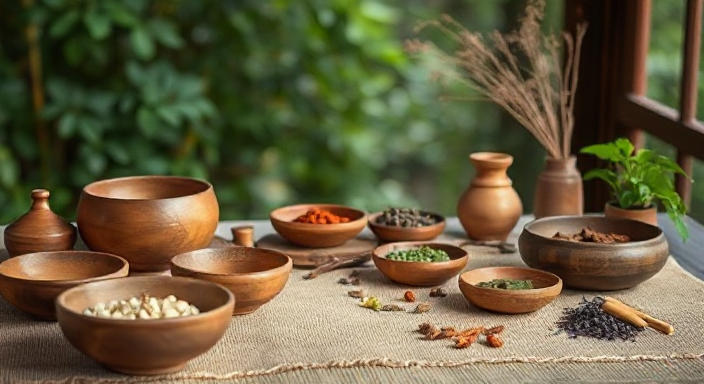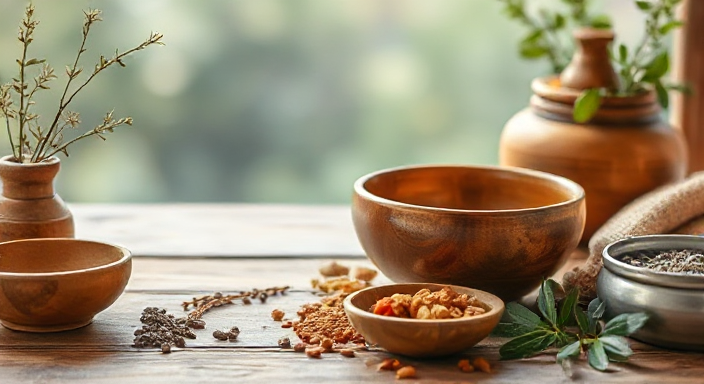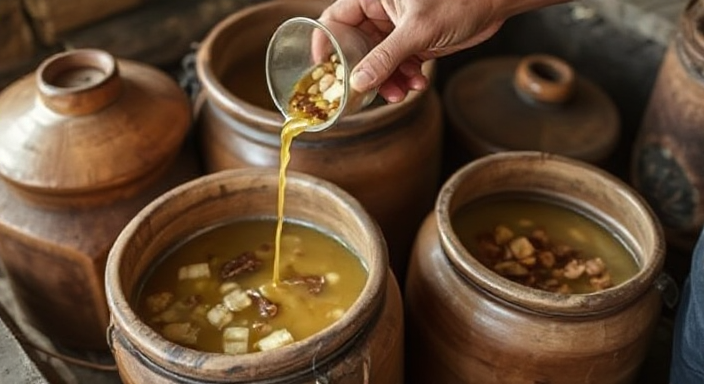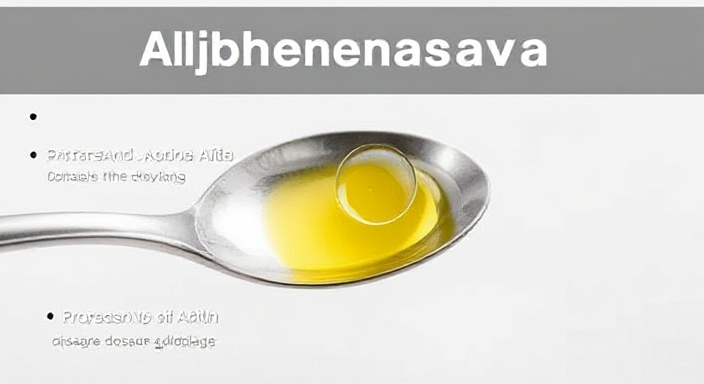Ahiphenasava: Introduction
Ahiphenasava, a traditional Ayurvedic formulation, occupies a unique space within the vast pharmacopeia of ancient Indian medicine. This fermented liquid preparation, known as an asava, holds a venerable history, its origins rooted in the age-old wisdom of Ayurveda. These asavas, typically produced through a process of fermentation, are not merely simple herbal infusions; they represent a sophisticated application of natural ingredients, carefully combined and transformed to achieve therapeutic efficacy.

Ahiphenasava, in particular, is often employed for its perceived digestive and rejuvenating properties. This article will delve into the intricacies of Ahiphenasava, exploring its ingredients, traditional applications, dosage guidelines, potential side effects, and essential precautions, offering a balanced perspective informed by both traditional understanding and modern insights.
Table of Contents
Ingredients: The Foundation of Ahiphenasava
It is a complex formulation comprised of various herbs, spices, and fermentable sugars, each contributing to its unique therapeutic profile. The selection and combination of these ingredients are based on the fundamental principles of Ayurveda, seeking to balance doshas (biological energies) and restore health. The following table outlines the primary ingredients, including their common names, botanical names, and their traditional Ayurvedic properties:

| Ingredient (Common Name) | Botanical Name | Ayurvedic Properties (Rasa, Guna, Virya, Vipaka) | Purported Role in Formulation |
| Draksha (Raisins) | Vitis vinifera | Madhura (sweet), Guru (heavy), Sheeta (cold), Madhura | Base for fermentation, nutritive, digestive, provides sweet taste |
| Madhu (Honey) | Apis mellifera | Madhura, Ruksha (dry), Sheeta, Madhura | Improves palatability, acts as a catalyst for fermentation, possesses medicinal properties |
| Dhataki Flower | Woodfordia fruticosa | Kashaya (astringent), Ruksha, Sheeta, Katu | Facilitates fermentation, imparts color, contains tannins which are astringent |
| Musta (Nutgrass) | Cyperus rotundus | Katu, Tikta (bitter), Ruksha, Sheeta, Katu | Digestive, carminative, anti-inflammatory |
| Trivrit (Indian Jalap) | Operculina turpethum | Katu, Tikta, Ruksha, Ushna (hot), Katu | Purgative, helps in removing toxins |
| Vidanga (Embelia) | Embelia ribes | Katu, Ushna, Laghu (light), Katu | Anthelmintic, digestive |
| Chitraka (Leadwort) | Plumbago zeylanica | Katu, Ushna, Ruksha, Katu | Digestive, carminative, improves appetite |
| Sonth (Dry Ginger) | Zingiber officinale | Katu, Ushna, Guru, Madhura | Digestive, carminative, anti-inflammatory |
| Marich (Black Pepper) | Piper nigrum | Katu, Ushna, Laghu, Katu | Digestive, improves appetite |
| Pippali (Long Pepper) | Piper longum | Katu, Ushna, Guru, Madhura | Digestive, carminative, expectorant |
| Ela (Cardamom) | Elettaria cardamomum | Madhura, Laghu, Sheeta, Madhura | Digestive, carminative, improves taste |
| Tejpatra (Bay Leaf) | Cinnamomum tamala | Katu, Ushna, Laghu, Katu | Digestive, carminative, anti-inflammatory |
| Twak (Cinnamon) | Cinnamomum zeylanicum | Katu, Madhura, Ushna, Katu | Digestive, carminative, improves circulation |
Understanding Ayurvedic Properties
The Ayurvedic properties (Rasa, Guna, Virya, and Vipaka) are fundamental to understanding the action of each ingredient and the formulation as a whole:
- Rasa: Taste – such as Madhura (sweet), Katu (pungent), Tikta (bitter), Kashaya (astringent), Amla (sour), and Lavana (salty).
- Guna: Qualities – such as Guru (heavy), Laghu (light), Sheeta (cold), Ushna (hot), Ruksha (dry), Snigdha (unctuous).
- Virya: Potency – whether an ingredient is heating or cooling in its action on the body.
- Vipaka: Post-digestive effect – the taste that arises after digestion, which can be Madhura (sweet), Amla (sour), or Katu (pungent).
These properties guide the selection of herbs in It, aiming to balance doshas and alleviate specific conditions. The combination is geared towards enhancing digestive fire (Agni), promoting assimilation, and reducing Ama (toxins).
Source and Quality of Ingredients
The effectiveness of It is heavily reliant on the quality of its ingredients. Traditionally, herbs are sourced from their native habitats, often collected during specific seasons when they possess peak potency. Modern practices, however, may involve cultivated herbs, which, if handled correctly, can be equally effective.
However, the quality of honey, raisins and spices used is also of prime importance. Adulteration is a prevalent problem with herbal products so it becomes important to ensure the ingredients are sourced from reputed and reliable sources. A certified Ayurvedic manufacturer would adhere to stringent quality control standards.
Traditional Uses of Ahiphenasava
Ayurvedic texts, particularly Bhaishajya Ratnavali and other classical treatises, outline the traditional uses of It. It is primarily recognized for its ability to:

- Improve Digestion: The ingredients like ginger, pepper, Musta, Chitraka, etc., stimulate digestive enzymes, helping to break down food efficiently. It is prescribed to those suffering from sluggish digestion, bloating, and gas.
- Reduce Ama (Toxins): The purgative herbs like Trivrit and others help in eliminating metabolic waste and accumulated toxins. This process is believed to cleanse the digestive system.
- Enhance Appetite: The combination of pungent and carminative herbs acts on the taste buds, improving appetite, and may also enhance the absorption of nutrients.
- Alleviate Gastrointestinal Discomfort: It is employed to relieve abdominal pain, colic, and other digestive discomforts due to impaired digestive functions.
- Provide Nutritive Support: The base ingredients such as raisins and honey offer nutritional support which is considered good for patients who are weak and debilitated.
It is worth noting that It is not considered a primary treatment for severe digestive conditions but acts more as a supportive remedy to balance digestive imbalances.
Top 10 Benefits and Uses of Ahiphenasava
| # | Benefit/Use | Description | Ayurvedic Principle/Basis |
| 1 | Improves Digestion | Stimulates digestive enzymes, aids in breaking down food, and improves nutrient absorption. Reduces gas, bloating, and indigestion. | Balances Agni (digestive fire) and normalizes Pachana (digestion) |
| 2 | Reduces Ama (Toxins) | Supports detoxification by promoting the elimination of metabolic waste products and accumulated toxins from the digestive tract. | Promotes Srotoshodhana (cleansing of channels) and Malashodhana (elimination of waste) |
| 3 | Enhances Appetite | Carminative herbs stimulate taste buds, increasing desire for food, and supporting proper digestion, absorption, and assimilation. | Deepana (appetizer) properties of herbs like ginger, pepper, etc. |
| 4 | Relieves Gastrointestinal Discomfort | Provides relief from abdominal pain, cramps, colic, and other discomforts arising from poor digestion, including flatulence and bloating. | Balances Vata and Pitta related to digestive imbalances |
| 5 | Supports Bowel Regularity | Mild purgative action helps promote regular bowel movements, thus preventing constipation and promoting overall gut health. | Anulomana (promoting downward movement) action, and the mild laxative effect of Trivrit |
| 6 | Nutritive Support | The base ingredients like raisins and honey provide nutrients that support overall health and can be beneficial for weak individuals. | Brumhana (nourishing) and Balya (strengthening) properties of ingredients |
| 7 | Improves Liver Function (Indirectly) | Through improving digestion and removing Ama, it indirectly supports healthy liver function by reducing the workload on the liver. | Improves Agni which in turn supports healthy liver functions and detoxification pathways |
| 8 | Anti-inflammatory Action | Some of the ingredients, such as ginger and cinnamon, have anti-inflammatory properties that may help reduce mild digestive inflammation. | Shotha hara properties of ingredients which can help with mild inflammation associated with digestive disturbances. |
| 9 | Anthelmintic Properties | Vidanga traditionally has anthelmintic properties that can support gut health by eliminating intestinal worms and parasites. | Krimighna action to remove intestinal parasites. |
| 10 | Supports Overall Well-being | By improving digestive functions, promoting detoxification, and providing nutrients, Ahiphenasava may contribute to improved overall health and well-being. | Balances doshas and supports Ojas (vitality) |
Important Notes:
- Traditional Perspective: These benefits and uses are based on traditional Ayurvedic principles and practices.
- Individual Variation: The effectiveness of It can vary based on individual Prakriti, health condition, and other factors.
- Not a Primary Treatment: It is not usually considered a primary treatment for severe conditions but more as a supportive and balancing remedy.
- Professional Guidance: Always consult a qualified Ayurvedic practitioner or healthcare professional before using It.
- Modern Evidence: Remember that modern clinical research specifically on It is limited, and the effects are often based on traditional use and the properties of its individual ingredients.
Primary vs. Secondary Uses
The primary focus of It is on improving digestive functions. However, its effects are also employed secondarily to support overall health, specifically in conditions that may be related to impaired digestion, like some inflammatory processes.
Modern Perspectives: Limited Scientific Evidence
While It has a long history of traditional use, there’s a lack of extensive modern scientific research to validate its efficacy. The herbs, individually, have shown some pharmacological activity in modern research:
Ginger for its anti-inflammatory properties, pepper for its bioenhancer role and the raisins for their anti-oxidant effects. However, studies specifically evaluating the synergistic effects of It combined formulation and its mechanism of action are very limited. Much of the evidence remains anecdotal and based on traditional understanding.
Preparation Methods
It is prepared through a traditional fermentation process, which involves:

- Infusion: The ingredients, either dried or fresh, are coarsely ground and added to a solution of raisins or other fermentable bases and honey.
- Fermentation: The mixture is then placed in a suitable vessel, often made of glass or clay, and kept in a warm place, allowing natural fermentation to occur. This natural fermentation is the key to the formation of active metabolites.
- Maturation: The formulation is allowed to ferment for a specific period (usually a few weeks or months), after which the liquid is strained and bottled.
- Quality Checks: In commercial manufacturing, standard quality control and analysis techniques are employed to ensure the quality of the finished product.
This process leads to the production of a mildly alcoholic liquid with the characteristic properties of the combined ingredients. Due to limited information available regarding proprietary manufacturing process, the above mentioned is generalized information of making asavas.
Dosage Guidelines
Dosage guidelines for It are typically based on age, body constitution (Prakriti), the condition being treated, and the individual’s digestive capacity. General recommendations from Ayurvedic texts are:

- Adults: 10 to 20 ml (2-4 teaspoons) twice daily after meals, or as directed by an Ayurvedic practitioner.
- Children: Dosage needs to be adjusted and significantly reduced. It’s best to avoid using Ahiphenasava in young children, or if necessary, administer very small doses under the guidance of a qualified practitioner. Dosage guidelines for children are not usually listed in classical texts.
- Specific Conditions: The dosage might vary based on the health condition being addressed. A higher dose may be employed for poor digestion, while a lower dose might be suitable for general support.
Importance of Prakriti
Ayurveda emphasizes individual variations. Prakriti (constitutional type) plays a significant role in determining the appropriate dosage. Individuals with a Pitta (fire) constitution should consume less since it has a heating effect due to the presence of spices, while those with a Kapha (earth and water) constitution might tolerate it better.
Dosage Forms
It is typically available as a liquid that is administered orally. It can be taken directly or diluted with a small amount of water. Some commercial brands are also available in capsule form.
Side Effects and Precautions
While generally considered safe when used correctly, It can have potential side effects:
- Digestive Disturbances: Overconsumption might lead to increased digestive irritation, heartburn, or diarrhea.
- Alcohol Content: The fermentation process leads to the production of alcohol. Individuals with alcohol sensitivities should use it with caution or avoid it completely.
- Allergic Reactions: Allergic reactions to any of the ingredients can occur. It’s essential to monitor for any unusual reactions.
- Interactions with Medications: It may interact with certain medications, particularly blood thinners or diabetes medications. Those on chronic medication must consult a physician before starting this formulation.
- Pregnancy and Breastfeeding: Due to the potential alcohol content and lack of safety data, it’s contraindicated during pregnancy and breastfeeding.
- Contraindications: It should not be used in cases of acute ulcers, ulcerative colitis, gastritis, and other acute digestive conditions.
The Importance of Professional Consultation
It is absolutely essential to consult a qualified Ayurvedic practitioner before using Ahiphenasava. This is particularly important if:
- You have underlying health conditions.
- You are taking prescription medications.
- You are pregnant or breastfeeding.
- You are unsure about your Prakriti or the appropriate dosage.
A healthcare professional can provide personalized recommendations and guide you on the safe and effective use of It.
Quality and Storage

To ensure quality and efficacy, choose It from reputed manufacturers who adhere to good manufacturing practices. The formulation should be stored in a cool, dark place away from direct sunlight and heat, preferably in a glass container with tight lid. It should be consumed within the expiry date and ideally once opened should be refrigerated after opening. Any change in colour, odor or consistency could indicate deterioration of product quality.
Disclaimer
The information provided in this article is intended for educational purposes only and should not be construed as medical advice. The use of It should always be under the guidance of a qualified healthcare practitioner. Self-treatment can be harmful and should be avoided.
Conclusion
It is a traditional Ayurvedic formulation with a rich history of use in addressing digestive issues. While traditional texts highlight its benefits, it is important to approach its use with a balanced perspective. Modern scientific validation is limited, and potential users should be mindful of its potential side effects, contraindications, and the presence of alcohol.
Prioritizing consultation with a qualified Ayurvedic practitioner or healthcare professional is paramount before considering its use. By adhering to these precautions, one can navigate the use of It responsibly and safely.
FAQs About Ahiphenasava
1. What exactly is Ahiphenasava?
It is a traditional Ayurvedic liquid formulation, classified as an asava. It’s made through the fermentation of a blend of herbs, spices, and fermentable substances, such as raisins and honey. This process creates a slightly alcoholic preparation that is primarily used to support digestion and promote overall well-being according to Ayurvedic principles.
2. What are the main ingredients in Ahiphenasava?
The key ingredients in It include a combination of herbs and spices. Some of the most important components are raisins, honey, Dhataki flowers, Musta (nutgrass), Trivrit (Indian jalap), Vidanga (embelia), Chitraka (leadwort), along with digestive aids like ginger, black pepper, long pepper, cardamom, bay leaf, and cinnamon. Each of these ingredients contributes its unique properties to the overall therapeutic effect of the formulation.
3. What are the primary benefits of taking Ahiphenasava?
It is traditionally used for several purposes, primarily to improve digestion, aid in the removal of toxins from the body, enhance appetite, relieve various gastrointestinal discomforts such as bloating and gas, and promote regular bowel movements. Additionally, its nutritive ingredients may offer some support for overall strength and well-being.
4. How should I take Ahiphenasava? What’s the typical dosage?
The typical adult dosage for It is around 10 to 20 ml, which equates to about 2 to 4 teaspoons. It’s usually taken twice daily after meals. However, the appropriate dosage can vary based on an individual’s unique constitution (Prakriti), their specific health condition, and, importantly, the guidance of an Ayurvedic practitioner. It is always advised to start with a lower dose and increase as needed while consulting with a healthcare provider.
5. Are there any side effects associated with taking Ahiphenasava?
Yes, there are potential side effects associated with It . These may include digestive upset, heartburn, or diarrhea, particularly if taken in excessive amounts. Due to the fermentation process, it contains alcohol, which can pose problems for some individuals. Allergic reactions to any of the individual ingredients are also possible, and individuals should be cautious.
6. Who should NOT take Ahiphenasava?
It is generally not recommended for pregnant or breastfeeding women due to its alcohol content and lack of comprehensive safety data. It’s also contraindicated for individuals with acute ulcers, ulcerative colitis, gastritis, or those with known alcohol sensitivities. It is essential for individuals with existing health conditions or those taking prescription medications to seek medical advice before use.
7. Can Ahiphenasava interact with other medications?
Yes, there is a potential for interactions between It and other medications. It is particularly important to be cautious with blood thinners or medications for diabetes, as it might interact with them. Always consult your doctor or an Ayurvedic practitioner if you are taking any prescription medications to ensure there are no contraindications.
8. How should Ahiphenasava be stored to maintain its efficacy?
For optimal preservation of its potency, It should be stored in a cool, dark place, away from direct sunlight and heat. A tightly sealed glass container is ideal for storage. Once opened, it is best to refrigerate the product and use it within its expiry period.
9. Where can I buy Ahiphenasava? And how do I ensure its quality?
It can typically be purchased from reputable Ayurvedic pharmacies or manufacturers. When buying, it is crucial to ensure the product is from a quality brand and adheres to good manufacturing practices. Look for quality certifications, avoid products with artificial additives, and always check the expiry date.
10. Is Ahiphenasava a cure for any specific disease?
No, It is not a cure for any specific disease. It’s primarily a supportive remedy used within the context of traditional Ayurveda to enhance digestive functions, help with detoxification, and improve overall well-being. It is essential to seek qualified medical advice for any specific health concerns or medical conditions.
